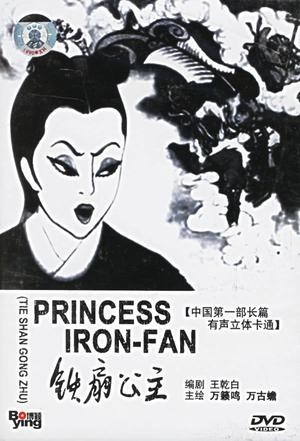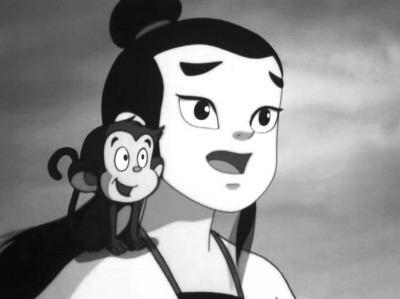Interesting Chinese cartoons and comics
The history of Chinese Animation began in the 20th century in the Republic of China when the people became fascinated with the idea of animation. Below are some great cartoon works in Chinese history, Please see which one you like best.
 Princess Iron Fan (铁扇公主)
Princess Iron Fan (铁扇公主)
Princess Iron Fan, is the first Chinese animated feature film. It was directed in Shanghai under difficult conditions in the thick of World War II by the Wan brothers and was released on 1942. It is the second longest cartoon film in world following the White Princess. The story was liberally adapted from a short sequence in the popular Chinese folk tale Journey to the West.
Emperor’s Dream (皇帝梦)
In 1947 the Northeast Film Studio, later be renamed to Changchun Film Studio produced the cartoon film Emperor’s Dream, which is considered the first puppet film made after foundation of new China. The story is about exposing the corruption of the Kuomintang nationalist party using puppets in an exaggerated fashion.
Go After an Easy Prey
It is a Chinese animated film in black and white from 1948. It is also referred to as “Turtle Caught in a Jar”.The film is believed to be more of a documentary view of China’s civil war in the 1940s when Chiang Kai-shek was considered to be favored and aided by U.S imperialism. He was metaphorically described as trapped like a turtle by the People’s Liberation Army.
Why Is the Crow Black-Coated (Chinese: 为什么乌鸦是黑的)
It is the first Chinese animation in color produced at the Shanghai Animation Film Studio by Wan Brothers Studio in 1955. The story is about an arrogant bird that enjoys life. He sang and dance in the forest in China, showing off his beautiful tail to everyone. Autumn would come and the other animals in the forest are busy preparing food for the winter. The bird continues to live life leisurely.
The Proud General (Chinese: 骄傲的将军)
It is a Chinese animated feature produced by Shanghai Animation Film Studio under the master animator Te Wei in 1956. It is also referred to as The Conceited General. The plot: After a victorious military campaign, a general returns home to glory and prosperity. The king rewards him and claims that all enemies will be intimidated by the general. From then on, the general no longer practices martial arts. He eats, drinks, lives the glamorous life, and doesn’t bother anymore with sharpening his weapons. When the enemy one day returns, his own arrogance leads to his defeat and eventually to the downfall of the whole nation.
Pigsy Eats Watermelon (Chinese: 猪八戒吃西瓜)
It is a chinese animation produced at the Shanghai Animation Film Studio in year 1958. It is also referred to as “Mr. Pig Eats Watermelon” or “Zhu Bajie Eats Watermelon”. The main character was Zhu Bajie, the Chinese folklore character from the literature Journey to the West. Though the story was considered more of a spin-off. The character was used, since pigs were often associated with greed in the culture.
Ji Gong’s Fighting Cricket (Chinese: 济公斗蟋蟀)
It was released by Shanghai Animation Film Studio in 1959 and the director is Wan Guchan.
Plot outline: During the Southern Song Dynasty, Zhang Yu, a carpenter working at the residence of Prime Minister Luo, learned that the Prime Minister’s son won a lot of money from cricket fighting. Out of curiosity, he had a peep at the cricket. Unexpectedly, the cricket escaped from the jar just as he opened the lid. The Prime Minister’s son broke out in a rage. He gave Zhang Yu a good beating, and required Zhang to compensate for the lost cricket within three days. In the desperate situation, Zhang was fortunately rescued by Ji Gong, who asked Zhang Yu to buy a half-dead cricket. Then Ji Gong took the cricket to the Prime Minister’s son, claiming that his cricket could beat a rooster. Then, the Prime Minister’s son ordered a servant to bring him a rooster and made a bet with Ji Gong. In the end, the cricket defeated the rooster, so the Prime Minister’s son bought the cricket with 500 ounces of silver. However, the cricket fooled the Prime Minister’s son and upturned the whole residence. The Prime Minister’s son was buried under the ruins. He was finally punished for his evil deeds by Ji Gong.
Where is Mama or Where’s Mama (小蝌蚪找妈妈)
It is a short Chinese animated film produced by Shanghai Animation Film Studio in 1960 under the artistic guidance of Te Wei. The narrated film describes the adventures and misadventures of a group of tadpoles in search of their mother. It is one of Te Wei’s first attempts to break away from Western style animation and aim for a painterly style influenced by Qi Baishi and more in keeping with native Chinese aesthetic sensibilities. Because of its simple story line and repetitive script it is ideal for children who are beginning their study of the Chinese language.
Uproar in Heaven or Havoc in Heaven (Chinese: 大闹天宫)
It is a Chinese animated feature film directed by Wan Laiming and produced by all four of the Wan brothers. The film was created at the height of the Chinese animation industry in the 1960s, and received numerous awards. It earned the brothers domestic and international recognition. Adapted from the ancient Chinese novel “Journey to the West”, this lively animated film depicts one of the most popular of the Monkey King stories – Fighting the Heavenly Army. The Monkey, Sun Wukong, cheated and jeered by the heavenly court, revolts and fights his way to earth to assume his rightful place as king. Follow his adventures, as the Emperor sends his army to catch the Monkey King.
Little Nezha Fights Great Dragon Kings (Chinese: 哪吒闹海)
The cartoon adventures of a small boy who challenges the mighty child-eating Dragon King of the Eastern Sea.
Three Monks (Chinese: 三个和尚)
It is a Chinese animated feature film produced by the Shanghai Animation Film Studio in 1980. It is also referred to as The Three Buddhist Priests. Plot: A young monk lives a simple life in a temple on top of a hill. He has one daily task of hauling two buckets of water up the hill. He tries to share the job with another monk, but the carry pole is only long enough for one bucket. The arrival of a third monk prompts everyone to expect that someone else will take on the chore. Consequently, no one fetches water though everybody is thirsty. At night, a rat comes to scrounge and then knocks the candleholder, leading to a devastating fire in the temple. The three monks finally unite together and make a concerted effort to put out the fire. Since then they understand the old saying “unity is strength” and begin to live a harmonious life. The temple never lacks water again.


